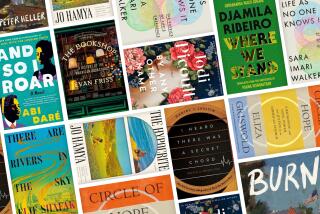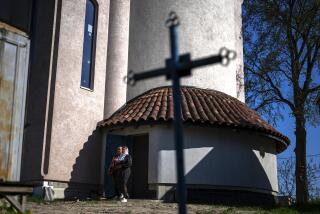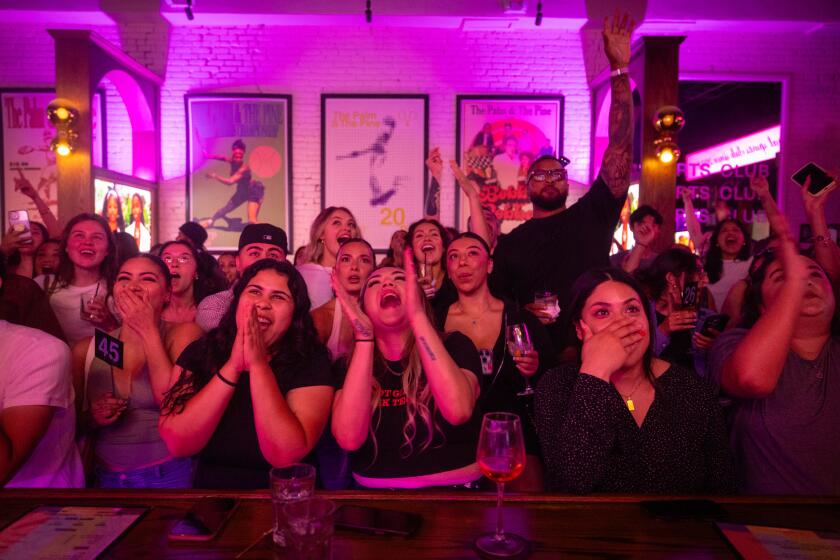Cycle of the Heart
- Share via
NOUL ROMAN, Romania — We stared up at the vivid frescoes on the walls and ceilings, dating back more than 300 years. The colors leaped out through centuries worth of accumulated soot. The outside walls were painted as well: scenes of judgment, resurrection and martyrdom; Adam and Eve, Cain and Abel, Moses.
Kat and I took turns wandering around the monasteries at Voronet, Humor, Putna and Moldavita, while the other kept watch over our bikes. We strolled with fellow tourists, armed with cameras to capture the experience, and purchased postcards to mail it home to friends and family.
We had read about the painted churches of Bukovina--in northeastern Romania--in our guidebooks. “Not to be missed,” was the consensus.
Yet there was something missing for us. We couldn’t put a finger on it, but we were disappointed. We both kept waiting for the moment when the experience would overwhelm us and send chills up our spines. But the only chills came from the cold breeze penetrating our sweaty T-shirts.
The missing elements wouldn’t surface until miles later.
We cycled into the small village of Noul Roman along a dirt track. It was late afternoon, last July. The Carpathian Mountains loomed in the distance: our next day’s destination. We’d snaked our way through the back roads without a detailed map by asking locals for directions each time we got to a fork in the road. In the middle of Noul Roman, the road split again.
We had just passed two friendly looking gentlemen, sitting on a bench with their backs resting on the plastered wall of a modest home. They had smiled and waved as we passed. Kat waited at the crossing, and I backtracked to ask directions.
The man whom we would soon refer to as “Mr. Bunea” indicated that we should take the road that veered right, then he motioned me to follow him into the courtyard of his home. With a grand wave he motioned for Kat to join us.
He was a strong, handsome-looking man, with shocking white hair, dressed in wool pants, a white shirt worn beneath a gray vest and sporting a matching gray cap. He spoke no English, but his smile beamed a welcome and his laugh charmed.
We sat down to what we thought would be a brief drink. We would not depart for two days.
As we drank the cool well water, the man’s wife, Maria, appeared and discovered two strangers sitting at her garden table. There was not an instant’s hesitation: She threw her arms up and welcomed us to their home with a warm hug.
Mr. Bunea indicated that it was getting late and we should not camp but stay in their home. We removed our gear from our bikes and were ushered into their guest room. The old black-and-white photos on the wall indicated that this had probably been their son’s room.
After we changed, Mr. Bunea took us on a tour of their orchard filled with apple trees and their garden brimming with lettuces. Their barn housed a couple of enormous pigs and several chickens and had stalls for two cows. Then he took us down into their cellar and proudly showed off their supply of homemade wine and plum brandy.
The sizzle and smell of pork fat greeted us as we sat back down at the garden table. Maria was busy cooking supper. Although 70 years old and permanently hunched over from osteoporosis, she was still a compact bundle of energy. Her appearance reminded me of a cute apple doll you buy at the fair.
But, we’d soon learn, she was an apple doll who could knock back a shot of plum brandy like a sailor.
Later that evening, literally after the cows came home, the Buneas invited some friends over for supper. They spoke English, so we were able to translate stories of our adventure to the Buneas.
We told them of our experience in the painted churches of Bukovina. They asked if we had ever been to a Romanian Orthodox service. We explained that we would have liked to, but we were worried that we would offend people if we showed up in our cycling clothes.
We learned that the Buneas had been childhood sweethearts and that Mr. Bunea had been the unofficial leader of the village during the brutal reign of Nicolae Ceausescu.
Mr. Bunea leaned over and told us, “Years ago if you had stopped and stayed with us, the next morning we would have been taken, blindfolded, to be interrogated.”
With no worries of visits from secret police, we laughed and joked the night away, drinking wine and plum brandy. Each time Mr. Bunea raised his glass, he bellowed, “William. Katy. Senetate” (Romanian for “good health”).
*
We awoke the next morning to the sound of cows making their way out to pasture down the main street and to the smell of eggs cooking. Mr. Bunea led us to the bathroom, where he had stoked the water heater with corncobs so that Kat and I could bathe.
It was Sunday, and our newfound grandparents had made it clear that we’d be attending church with them.
Kat and I searched our packs for our cleanest clothes. But several weeks on the road had left us with only worn and torn alternatives. I tried to imagine in what situation I’d feel more self-conscious than in attending a Romanian Orthodox church in cycling shorts and a faded and wrinkled T-shirt.
After breakfast and a hot shower, Maria took us both by the hand and led us upstairs to the attic. There she opened up a grand trunk and began pulling out beautiful black and white garments, embroidered with yellow thread--clothing once worn by their children. By the time she was finished, Kat and I were dressed in traditional Romanian costumes.
*
My ensemble fit beautifully, except for the thick leather waist belt that threatened to fall off. Mr. Bunea produced an awl and punched an extra hole for the skinny cyclist. He indicated by patting his belly that if only I’d stick around and eat more of Maria’s cooking, the belt would soon fit with no alterations.
We arrived late to the small, freshly painted church--white stucco under a clay-shingled roof--and squeezed our way in among about 120 villagers.
The smell of frankincense wafted over us as it had at the monasteries. But here it mixed with the sweat and perfume and body heat of the villagers around us, instead of damp, cold air.
The priests and deacons chanted the liturgy that has barely changed in more than a thousand years. Their voices mixed with villagers’ whispers of “Americans” and “biciclete” and the clinking of coins dropped in silver offering plates.
This is what had been missing from the churches of Bukovina: life.
Mr. Bunea and I found stiff wooden pew seats on one side of the church; Kat and Maria stood on the other with the women, before being offered seats.
Throughout the service I tried to appear reverent, but I was like a little kid, grinning widely and gazing at everything around me: the candles, the tapestries, the newly painted frescoes, the little boy sneaking bites of a piece of bread, the rough worker’s hands that lay formally folded. . . .
*
Occasionally I would catch Kat’s eye, and we would exchange a “can-you-believe-we’re-here?” smile.
After the final “Amens,” we filed out of the church and accepted the traditional gifts of bread and candles. We stood out in the hot summer sun, but minutes later were ushered back in.
Twin baby boys were being baptized, and their mother wanted us to witness it. As the priest sprinkled water on the two squirming babies, Maria grabbed Kat’s hand and Mr. Bunea put his hand on my shoulder.
That afternoon we cycled out of Noul Roman, a small village not found in most guidebooks. We turned one last time to wave to Mr. Bunea and Maria. We heard Mr. Bunea’s voice as it bellowed, “William. Katy. Senetate!”
A Romanian poet once wrote, “Eternity is found in the village.”
So is Romania.
(BEGIN TEXT OF INFOBOX / INFOGRAPHIC)
GUIDEBOOK
Village People in Romania
Getting there: Swissair, KLM and British Air fly, with one change of planes, from LAX to Bucharest, Romania. Advance-purchase, round-trip fares start at $965.
Where to stay: The medieval walled city of Sighisoara and Romania’s capital, Bucharest, have hotels, but since we were bicycling through the countryside, we didn’t investigate them. When we stayed in cities, we stayed with local people. We found the “Rough Guide: Romania” guidebook, which lists hotels, to be useful. In the countryside, we camped. Romania is a camper’s paradise, and travelers and locals camp everywhere in the style referred to locally as “Wild Camping.” But if you show up in the middle of most tourist towns, within five minutes someone will approach you offering a room to rent. They’ll be happy to walk you to their home and show you the room before you pay. We found the going rate to be between $2 and $12 per room for both of us, typically payable in U.S. currency--usually in $5 and $10 bills minted after 1990. Newer bills are preferred because they are more difficult to counterfeit. You can hold them up to the light and look for the anti-counterfeit strip that runs along the left-hand side of the bill as the president faces you. Money changers in particular will not accept dollars unless they have this strip. ($1 bills do not have it.)
Where to eat: One guidebook warned us that food would be scarce in Romania. In the villages, we found the food to be basic but plentiful. Most stores sell pasta and cookies. We bought our milk from local farms (about 50 cents for a half-gallon container). In almost every town we found a bakery, and, armed with an enormous loaf (4 to 7 pounds, about 80 cents), we would cycle out into the countryside looking for brightly colored beehives. There we would buy honey from beekeepers and have a perfect cyclist’s meal: fresh honey on fresh bread. Only in cities did we dine in restaurants.
For more information: Romanian National Tourist Office, 342 Madison Ave., Suite 210, New York, NY 10173; (212) 697-6971.
More to Read
Sign up for The Wild
We’ll help you find the best places to hike, bike and run, as well as the perfect silent spots for meditation and yoga.
You may occasionally receive promotional content from the Los Angeles Times.





